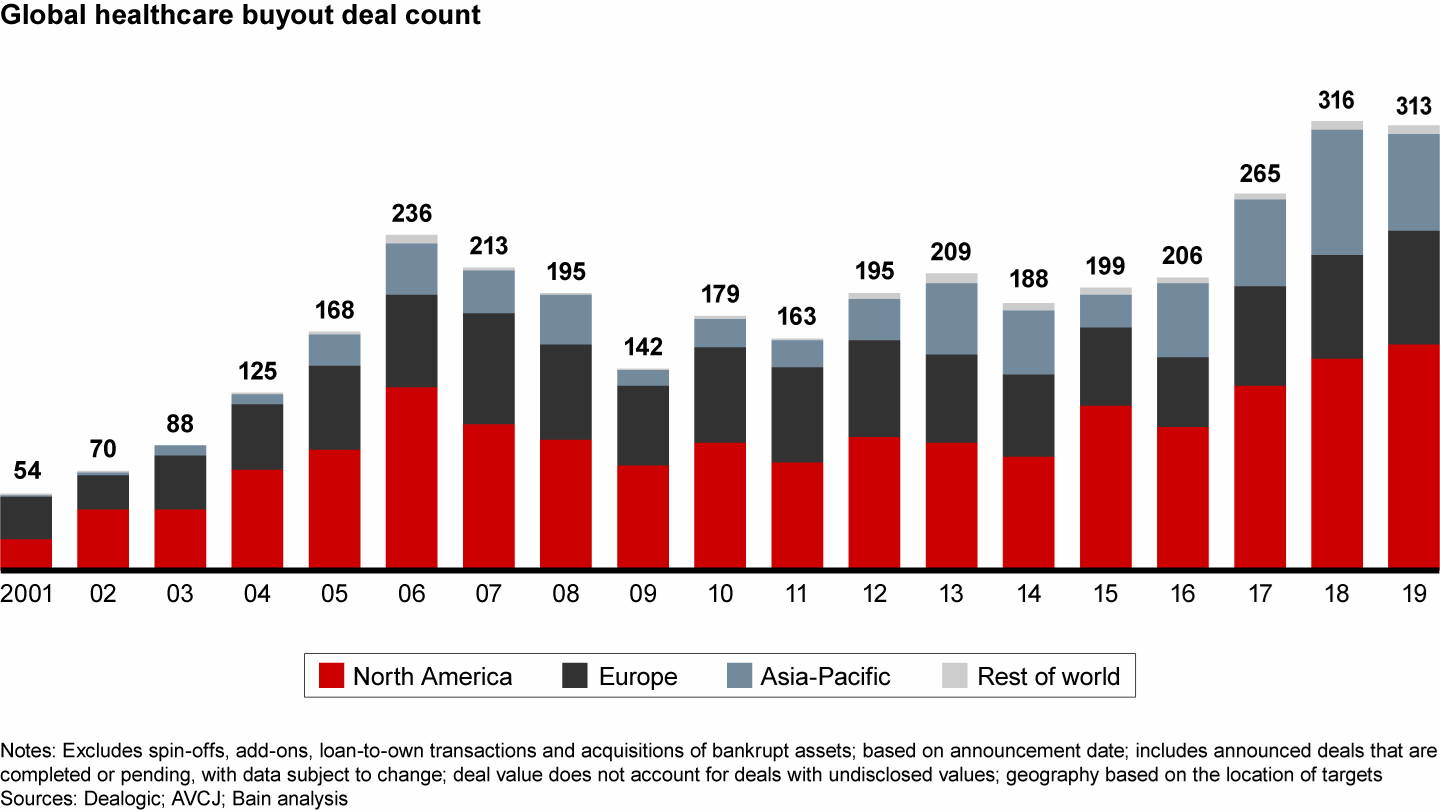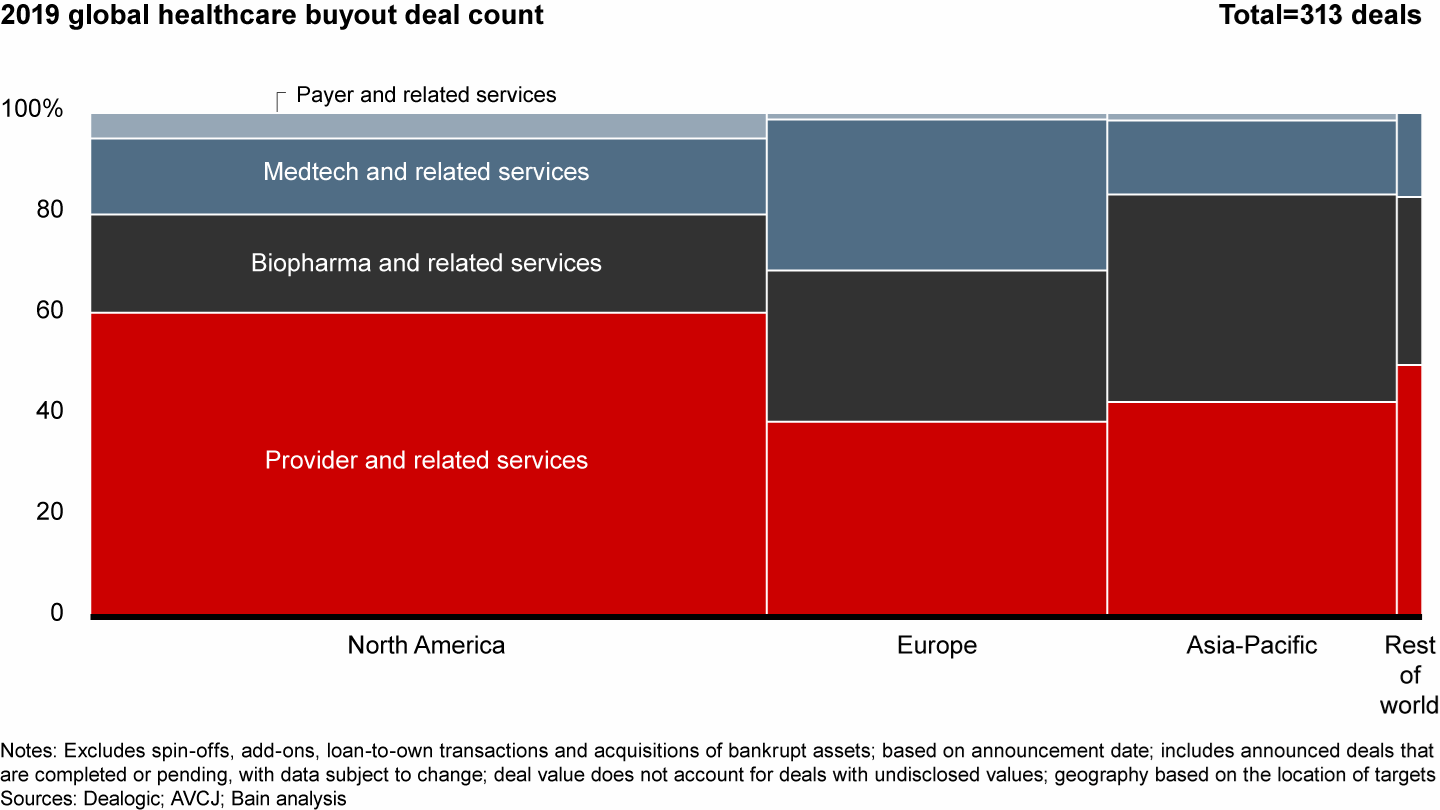Report

In evidenza
- Intense competition for assets came from many different entities, including very large buyout funds, European funds, tech-focused funds and corporates. That led to creative partnering as well as some funds maintaining a minority stake after a partial exit.
- Disclosed deal value rose to $46.7 billion in 2019, compared with $29.6 billion at slightly higher deal volume compared with 2018, as the average deal size continued to increase.
- Value rose on the back of deals between $1 billion and $5 billion, but there were no megadeals or large public-to-private takeovers. Provider remained the most active sector with 96 deals, or 60% of all deals in 2019.
- Healthcare remains quite resilient to macroeconomic factors, as shown by its solid performance in previous recessions.
This article is part of Bain’s 2020 Global Healthcare Private Equity and Corporate M&A Report. Explore the contents of the report here or download the PDF to read the full report.
Healthcare investment in North America has been riding a wave of favorable long-term trends, notably an aging population, the rising incidence of chronic disease and expanded access stemming from legislative action (see Figure 4).
Deal activity increased in North America and Europe, offsetting a decline in Asia-Pacific


In 2019, regulatory uncertainty has played a bigger part of the diligence approach in many sectors. The extra scrutiny required gives slight advantages to investors who are more comfortable with healthcare-heavy assets, such as in behavioral health (see the chapter “Investors Must Consider Effects of Healthcare Regulatory Reform”).
Despite some uncertainties in the market, deal value rose substantially from $29.6 billion in 2018 to $46.7 billion in 2019, as financial sponsors continued to execute large deals.
More capital than ever has been chasing healthcare investments in North America. A broad set of funds are pursuing deals in the space:
- European funds such as Cinven, EQT, JAB Holding, Nordic Capital and Partners Group;
- some tech-focused funds such as Genstar Capital and Vista Equity Partners; and
- funds that historically have excelled in this North American sector.
Getting creative through partnerships and minority interests
Strong competition for assets and high valuations have prompted buyout firms to employ more creative strategies in order to win deals.
For example, some firms teamed up as a way to spread risk and gain access to large assets with high multiples. EQT sold Press Ganey, a provider of industry-leading patient surveys and support for understanding the patient experience, to a consortium including ADIA, Leonard Green, Ares and British Columbia Investment Management Corporation, for $4.2 billion. Press Ganey’s value had doubled since EQT bought Press Ganey through a public-to-private transaction for $2.35 billion in 2016, making for an attractive equity outcome.
In another PE fund-corporate partnership, TowerBrook Capital Partners and Ascension Health, a health system, acquired Compassus, a hospice provider based in Tennessee, for $1 billion. This was the third time that TowerBrook and Ascension had partnered with each other. And Welsh, Carson, Anderson & Stowe and Walgreens invested in Shields Health, a specialty pharmacy services provider.
Other buyout funds retained minority interests in assets upon exit, allowing them to lock in a portion of gains at current valuations while also potentially enjoying upside in the future.
For example, Bain Capital retained a minority interest in Waystar, which it sold to EQT and Canada Pension Plan Investment Board (CPPIB). Nordic Capital retained equity in ERT after Astorg Partners invested.
Providers and related services: The largest sector keeps getting larger
The provider and related services sector once again accounted for the most deals, with 96 in 2019, up from 84 in 2018 (see Figure 5).
The provider sector continued to be the most active across all regions


Retail health continued brisk activity on the strength of its underlying fundamentals, including favorable demand, lower reimbursement exposure and buy-and-build potential. For example, Partners Group acquired EyeCare Partners, an operator of optometry clinics, from FFL Partners for $2.2 billion.
Behavioral health also attracted investors who recognize the positive macro factors of population growth, an increasing awareness and destigmatization of mental health and substance abuse, treatment gaps and a favorable regulatory environment. One hot area was treatment for autism, as evidenced by deals such as Thomas H. Lee Partner’s acquisition of Centria Healthcare, a provider of therapy services to children with autism, as well as other nursing services.
Likewise, investors in home/hospice care looked to establish delivery models to benefit from macro trends such as an aging population, as well as the chance to further consolidate a fragmented segment. Advent bought AccentCare, a provider of home health services, and Centerbridge Partners acquired Civitas Solutions, a provider of home- and community-based health services, in a deal announced in 2018 and completed in 2019.
Investors see attractive opportunities for physician practice management (PPM) across specialty areas including radiology, gastrointestinal (GI), ophthalmology and dermatology that are still fragmented compared with more traditional specialties such as emergency and anesthesia. There is a lot to like about certain assets if they have the right model to drive organic and inorganic growth.
Payers and related services: A scarcity of assets
Asset scarcity and intense competition in the payer and related services sector pushed multiples higher, particularly for gem assets. Prominent investment themes included the following:
- payment and revenue cycle management solutions;
- businesses that support Medicare Advantage delivery, to capitalize on growing enrollment;
- businesses that reduce costs of self-funded employer plans; and
- realignment of the value chain as payers looked to expand revenue streams outside of risk-bearing revenue.
While deal activity in 2019 matched 2018 levels, with 8 in 2019 and 10 in 2018, disclosed value rose sharply to $3.5 billion in 2019 compared with less than $1 billion in 2018. This resulted largely from two deals: Bain Capital’s investment in Zelis Healthcare and RedCard Systems, and Centerbridge’s acquisition of GoHealth, an online health insurance marketplace, for $1.35 billion.
Biopharma and related services: Services and branded pharmaceuticals
Biopharma and related services disclosed deal value surged from $1.9 billion in 2018 to $17.3 billion in 2019, representing 37% of North American value and 19% of deal activity.
Investments in biopharma included services like contract design and manufacturing organizations as well as cell and gene therapy. TPG and Vida Ventures joined for a $235 million investment in Asklepios BioPharmaceutical, a manufacturer of adeno-associated virus gene therapeutics. In addition, branded pharmaceuticals found buyers.
Bain Capital exemplified the trend of large-cap buyout firms establishing life science funds as it raised $900 million for its second such fund.
Medtech and related services: Investors like category leaders and outsourced services
Medtech and related services represented 15% of deals and 5% of the disclosed value. This share of deal count remained in line with previous years, though the share of value declined from 15% in 2018. Deal activity in the medtech space has been lumpy, so a decline in one year’s deals does not necessarily indicate a larger trend.
Investors showed continued interest in category leaders. They also focused on outsourced services, which allow investors to tap into medtech’s attractive fundamentals and capitalize on the growing trend of outsourcing noncore functions. For example, Nordic Capital acquired Orchid Orthopedics Solutions, a medical device outsourcing service that does contract design and manufacturing, for nearly $1 billion.
Corporate acquirers kept their hand in medtech. Carlisle Companies, for instance, acquired Providien, a provider of comprehensive manufacturing solutions for medical device companies.
In consumer medtech, PE firms also took advantage of opportunities to carve out business units that had been overlooked by their corporate parent, such as Hologic selling Cynosure, a medical aesthetics company, to Clayton, Dubilier & Rice for $205 million. It is worth noting that consumer medtech assets are beginning to reach a scale that draws interest from public markets. For example, SmileDirectClub, an affordable direct-to-consumer teeth-straightening service, raised $1.3 billion in an IPO.
HCIT: A number of hot segments
A wide range of investors flocked to HCIT. They propelled growth to 42 deals in 2019, up from 32 in 2018, with a disclosed value of $17.1 billion, up from $8.3 billion.
Several segments drew particular interest. For instance, financial sponsors favored derivative plays of high-growth sectors, such as solutions for pharma trials and alternative site electronic medical records (EMR). Warburg Pincus invested in Qualifacts, an EHR software for behavioral health and human services, and in WebPT, an EMR provider for physical therapists.
Other hot segments include assets designed to improve financing flows, an example of which is the Golden Gate Capital investment in RCM provider Ensemble Health Partners. Companies that manage costs in self-funded employer plans also drew interest, as evidenced by Great Hill Partners’ investment in Pareto, following its previous investment in Quantum Health in 2017.
Finally, financial sponsors jumped at opportunities in healthcare data. Case in point: Advent’s acquisition of Definitive Healthcare.
Strong fundamentals will continue, but there is less room for error
We expect the North American buyout market to remain robust based on attractive underlying fundamentals, high levels of dry powder chasing assets, and the recession-resilient nature of the industry. North American healthcare assets acquired during a recession tend to outperform investments in most other sectors. According to Bain analysis in an exclusive partnership with CEPRES, North American healthcare PE investments made during the past recession had a multiple on invested capital (MOIC) of 2.7, vs. 1.8 for other industries.
Strong demand for assets and intense competition from a range of financial sponsors and corporate buyers are likely to keep valuations and multiples high for the foreseeable future, particularly for gem assets. That leaves investors with less room for error, highlighting the need for integrated due diligence and delivering on an ambitious value creation plan.
This article is part of Bain’s 2020 Global Healthcare Private Equity and Corporate M&A Report. Explore the contents of the report here or download the PDF to read the full report.